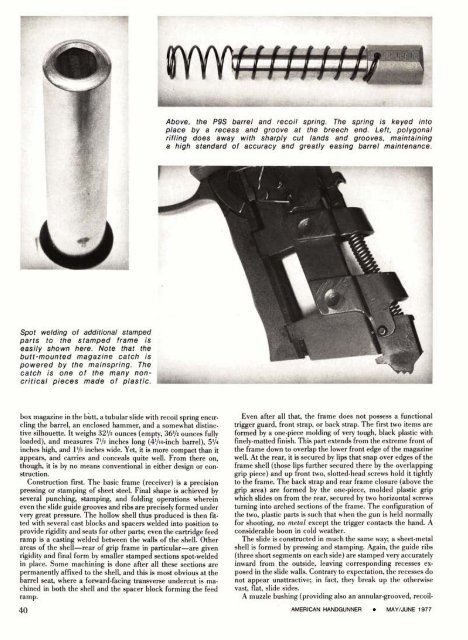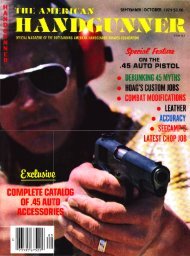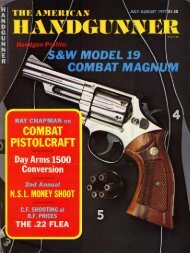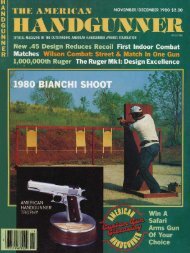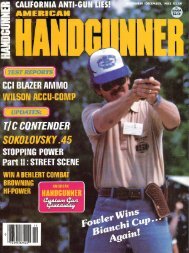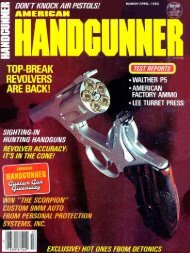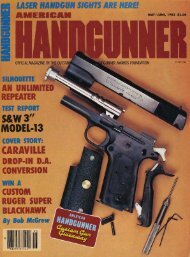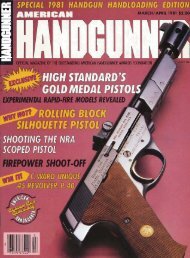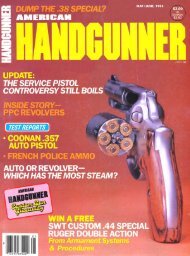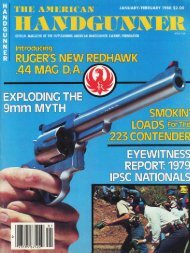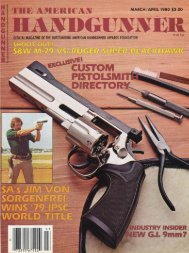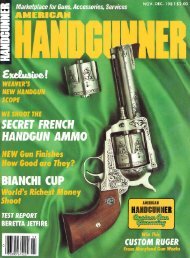Above, the PQS barrel and recoil spring. 'The .spring i$ keyed intoplace by a recess and groove at the breech end. Left, polygonalrifling does away with sharply cut lands and grooves,. maintaininga high standard of accuracy and greatly easing barrel maintenance.Spot welding of additional stampedparts to the stamped frame iseasily shown here. Note that thebutt-mounted magazine catch ispowered by the mainspring. Thecatch is one of the many noncriticalpieces made of plastic.box magazine in the butt, a tubular slide with recoil spring encirclingthe barrel, an enclosed hammer, and a somewhat distinctivesilhouette. It weighs 32'12 ounces (empty, 36'12 ounces fullyloaded), and measures 7'12 inches long (4'110-inch barrel), 5'14inches high, and 1'13 inches wide. Yet, it is more compact than itappears, andcarries and conceals quite well. From there on,though, it is by no means conventional in either design or construction.Construction first. The basic frame (receiver) is a precisionpressing or stamping of sheet steel. Final shape is achieved byseveral punching, stamping, and folding operations whereineven the slide guide grooves and ribs are precisely formed undervery great pressure. The hollow shell thus produced is then fittedwith several cast blocks and spacers welded into position toprovide rigidity and seats for other parts, even the cartridge feedramp is a casting welded between the walls of the shell. Otherareas of the shell-rear of grip frame in particular-are givenrigidity and final form by smaller stamped sections spot-weldedin place. Some machining is done after all these sections arepermanently affixed to the shell, and this is most obvious at thebarrel seat, where a forward-facing transverse undercut is machinedin both the shell and the spacer block forming the feedramp.Even after all that, the frame does not possess a functionaltrigger guard, front strap, or back strap. The first two items areformed by a one-piece molding of very tough, black plastic withfinely-matted finish. This part extends from the extreme front ofthe frame down to overlap the lower front edge of the magazinewell. At the rear, it is secured by lips that snap over edges of theframe shell (those lips further secured there by the overlappinggrip piece) and up front two, slotted-head screws hold it tightlyto the frame. The back strap and rear frame closure (above thegrip area) are formed by the one-piece, molded plastic gripwhich slides on from the rear, secured by two horizontal screwsturning into arched sections of the frame. The configuration ofthe two, plastic parts is such that when the gun is held normallyfor shooting, no metal except the trigger contacts the hand. Aconsiderable boon in cold weather.The slide is constructed in much the same way; a sheet-metalshell is formed by pressing and stamping. Again, the guide ribs(three short segments on each side) are stamped very accuratelyinward from the outside, leaving corresponding recesses exposedin the slide walls. Contrary to expectation, the recesses donot appear unattractive; in fact, they break up the otherwisevast, flat, slide sides.A muzzle bushing (providing also an annular-grooved, recoil-AMERICAN HANDGUNNER MAY/JUNE <strong>1977</strong>
spring seat) and rear slide closure are welded into the sheet-meta1shell.All of this welding, incidentally, is done and finished in such amanner that the joints are invisible on the external surface of thefinished gun. It may also be said truthfully that the use ofstamped sheet metal is not obvious until one looks inside thegun.Internally, the slide contains a separate breech block and bolthead, and a transverse-shafted, manual safety. The block isaligned vertically by ribs stamped into the slide shell, and securedhorizontally by the safety shaft, while the head rides on theblock. All three of'these parts appear to be machined entirelyfrom bar stock. Strangely, the fixed, front and rear sights, dovetailedlaterally into the top of the slide, are molded from somevery sturdy plastic.There is yet the barrel. Construction is fairly conventional, thebarrel assembly consisting of a two-diameter tube stronglypinned into an intricately machined breech piece peculiar to theVorgrimmler locking system the P9S employs. Rifling is of anunusual, but by no means new, "polygonal" type without sharplydefined lands and grooves, and is formed by hammer-forgingamethod originally developed in Germany and now widely employedthroughout the world.Construction of internal parts followsthe lead of major components. Extensiveuse is made of stampihgs and castings,and of weldments of either or both. Itshould be noted that these parts do not exhibitthe flimsiness, rapid wear, and raggedappearance typical of stamped partsin earlier domestic guns. The P9S haspassed with distinction many severe militaryacceptance tests and this alone is ampleevidence of the sturdiness of its construction.So much for construction, which is extremelyadvanced and should be evaluatedon its merits of low weight, cost effectiveness,and great strength and rigidity,rather than in regard to reconceived prejudicesagainst sheet-metal stampings infirearms.So, let's take a look at the unique designof the P9S. A very important design featureis evident from the construction details.The entire design is integrated withthe latest metal-fabrication technologywhich makes maximum use of a limitedamount of material. That same technologyis also the most economical for producinglarge quantities and requires the leastamount of strategic materials, machinery,and tools. Any design that meets thoseparameters (especially in time of ~eace) isespecially noteworthy.But it's the mechanical nature of the designthat is of primary interest to shootersand professional gun-carriers, especiallyas those features effect handling, safety,reliability, and to lesser degree, accuracy.The P9S locking system is containedentirely within the slide and is independentof the frame assembly except as it anchorsthe fixed, non-recoiling barrel. It isoften known as the CETME system,though originally developed late in WWIIby Vorgrimmler for Mauserwerke. It employsa longitudinally movable bolt headcontaining two, vertical rollers which arecammed outward into appropriate recessesin the barrel extension, thus lock-AMERICAN HANDGUNNER * MAY/JUNE 197ing bolt head and barrel together, when the slide is fully forwardin battery position.When thus locked, the rollers are supported outward by auniquely-shaped ramp on the sides of the breech-block extension.This extension enters the bolt head horizontally, which isfree to reciprocate on it a short distance. The firing pin passesthrough this extension, but more on that later.The barrel is fixed to the frame, with the slide and its pansmovable upon both. Barrel and bolt head (through the extension)are locked together by the rollers at the instant of firing. Aspressure builds up in the bore, the case head is thrust hardagainst the bolt face, tending to force the bolt away (rearward)from the barrel; this force acts upon the rollers, causing them totry to roll up the rear edge of their recesses in the barrel extension;they are prevented from doing so by the breech-block extension(locking finger) wedged between them; however, the extensioncontains carefully shaped ramps and pressure transferredthrough the rollers to the ramp slowly cams the extension(thus the breech block and slide) rearward while holding thebolt head tightly against the barrel breech; as the tapered extensionmoves back, it provides clearance for the rollers to come(Continued on page 64)The exploded parts diagram reveals the moderately complex innardsof the Heckler and Koch P9S. Note unique frame/grip assembly.


